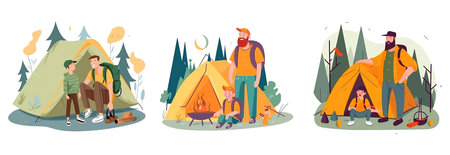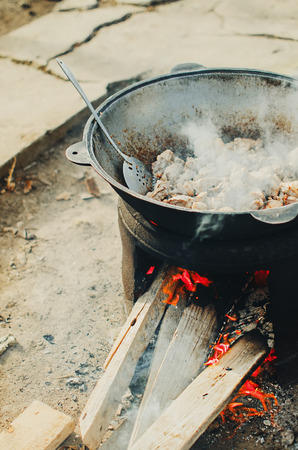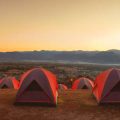Meal Planning for the Outdoors
When youre feeding a big group out in the wild, good meal planning is your secret weapon. Whether youre camping with family, friends, or a scout troop, creating a balanced and satisfying menu that fits everyones needs can make or break your trip. Here’s how to make sure no one goes hungry — and you don’t go crazy trying to feed them.
Start with a Headcount and Dietary Needs
Before you even think about food, get an accurate headcount. Ask about allergies, dietary restrictions (like vegetarian, gluten-free, or dairy-free), and preferences ahead of time. This helps avoid last-minute surprises and ensures everyone has something to eat.
Plan for Energy and Balance
Camping means hiking, swimming, chopping wood — all things that burn a lot of calories. Your meals should fuel these activities. Aim for a mix of protein, carbs, and healthy fats to keep energy levels steady throughout the day.
| Meal | Energy Source | Example Foods |
|---|---|---|
| Breakfast | Carbs + Protein | Oatmeal with nuts and dried fruit, breakfast burritos with eggs and cheese |
| Lunch | Light but Filling | Wraps with hummus and veggies, trail mix, fresh fruit |
| Dinner | Hearty & Satisfying | Pasta with meat sauce, chili with beans and cornbread, grilled sausages with veggies |
| Snacks | Quick Energy Boosts | Granola bars, jerky, peanut butter crackers, fruit leathers |
Think About Storage and Cooking Methods
You wont have a fridge in the woods (unless youre glamping), so plan meals around what keeps well. Use coolers wisely — pack perishable items like meat or dairy at the bottom where its coldest. Choose shelf-stable foods when possible.
Storage-Friendly Ingredients:
- Canned beans and vegetables
- Dried pasta and rice
- Shelf-stable milk or powdered milk
- Vacuum-sealed meats or foil-pack tuna/chicken
- Hard cheeses like cheddar (they hold up better without refrigeration)
Simplify Prep with Make-Ahead Meals
Prepping food at home saves tons of time at camp. Chop veggies ahead of time, pre-cook ground beef for tacos or spaghetti, or assemble foil packet meals you can just throw on the fire.
Easy Make-Ahead Ideas:
- Taco Kit: Pre-cooked seasoned beef + tortillas + shredded cheese + salsa packed separately.
- Pancake Mix: Just add water dry mix stored in zip bags with instructions written on the outside.
- Foil Dinners: Meat + potatoes + veggies wrapped in foil — ready for the fire.
- Pasta Salad: Keeps well in a cooler; great for lunch or side dish.
Create a Simple Meal Schedule
A basic meal schedule helps keep you organized and ensures you’re not repeating meals too often. Here’s an example for a 3-day weekend trip:
| Day | Breakfast | Lunch | Dinner |
|---|---|---|---|
| Friday (Arrival) | N/A (Eat before leaving) | Deli sandwiches & chips | Burgers & grilled corn on the cob |
| Saturday | Pancakes & sausage links | Pita wraps & trail mix | Chili & cornbread cooked over campfire |
| Sunday (Departure) | Bacon & scrambled eggs with toast | Leftovers or PB&J sandwiches on the go | N/A (Drive home) |
The key is planning smart so you spend less time cooking and more time enjoying the outdoors with your crew. With some prep and creativity, feeding a hungry crowd at camp can be fun — not frustrating!
2. Prepping Ahead for Success
When youre feeding a large group at a campsite, the key to smooth mealtimes is doing as much work as possible before you even pack the car. Prepping ahead saves time, reduces stress, and helps you enjoy more of the great outdoors instead of being stuck at the camp stove.
Chop, Slice, and Dice at Home
One of the easiest ways to save time at the campground is by prepping your ingredients in your home kitchen. Dice onions, slice bell peppers, mince garlic, and portion out spices into small containers or zip-top bags. Label everything clearly so you can find it quickly when it’s time to cook.
Example: Veggie Prep Checklist
| Ingredient | Prep Method | Storage Tip |
|---|---|---|
| Onions | Diced | Store in airtight container or zip bag |
| Bell Peppers | Sliced | Layer with paper towel to absorb moisture |
| Mushrooms | Sliced | Keep in breathable container to avoid sogginess |
| Zucchini | Sliced or cubed | Use within 1–2 days for freshness |
Pre-Cook Meals and Components
If your group loves chili, pasta, taco meat, or breakfast burritos, consider cooking these at home and freezing them flat in zip-top bags. Then all you have to do at camp is reheat over a stove or fire. This not only cuts down on cook time but also makes cleanup easier.
Top Make-Ahead Meal Ideas:
- Beef or veggie chili – freeze in meal-sized portions
- Pasta sauce – pair with pre-cooked noodles or boil fresh at camp
- Taco meat – beef, chicken or beans with seasoning ready to go
- Scrambled egg mix – beat eggs with veggies and cheese, store in pourable bottle
Use Marinades and Freezer Packs for Easy Flavor Boosts
Marinate proteins like chicken, steak, or tofu before your trip. Store them in freezer bags and freeze them flat — they’ll double as ice packs in your cooler! As they thaw at camp, they’ll be ready to toss on the grill or skillet with no extra prep.
Pro Tip:
Create “meal packs” by combining pre-marinated meats with chopped veggies in foil packets. Toss them directly onto hot coals or a grill for a no-mess dinner that’s packed with flavor.
The Bottom Line: A Little Prep Goes a Long Way
By taking care of chopping, cooking, and seasoning before you leave home, you’ll spend less time working and more time enjoying meals around the campfire with your crew. Whether its a weekend trip or a week-long adventure, smart prepping sets you up for camping success.

3. Camp Cooking Gear Essentials
When youre cooking for a group at camp, having the right gear makes all the difference. You don’t need a full kitchen setup, but you do need tools that are versatile, durable, and sized for feeding a crowd. Here’s a breakdown of must-have cooking equipment that will help you prepare meals smoothly and efficiently.
Large Coolers
Keeping your food fresh is priority number one. For group camping, bring at least one large cooler—preferably two: one for perishable food and another for drinks and ice. Look for coolers with thick insulation and consider adding frozen water bottles or block ice to extend cooling time.
Portable Stoves
A reliable portable stove is essential when cooking in the great outdoors. Two-burner propane stoves are ideal for group meals because they allow you to cook multiple dishes at once. Make sure to pack extra fuel canisters so you don’t run out mid-meal.
Dutch Ovens
This heavy-duty cast iron pot is a game-changer for camp cooking. Whether youre baking cornbread, simmering chili, or making a hearty stew, a Dutch oven distributes heat evenly and can be used over an open fire or on a camp stove.
Griddles and Grill Plates
Flat-top griddles are perfect for cooking pancakes, bacon, burgers, or grilled veggies for a crowd. Many portable stoves can accommodate removable griddle tops, or you can bring a standalone grill plate to use over the fire.
Quick Gear Checklist
| Gear | Purpose | Tips |
|---|---|---|
| Large Cooler | Keep perishables cold | Use block ice for longer cooling |
| Two-Burner Stove | Cook multiple dishes simultaneously | Pack extra fuel |
| Dutch Oven | Bake and slow-cook meals | Pre-season before trip |
| Griddle Plate | Cook breakfast or grill food | Bring non-stick spray or oil |
Other Handy Tools to Pack
- Lighter & Waterproof Matches: Always have backups to get your fire going.
- Pots & Pans: Go for nesting sets made for camping—they save space.
- Tongs & Spatulas: Long-handled ones are safer around open flames.
- Cutting Board & Knife: Essential for prepping ingredients on-site.
- Washing Station: Bring collapsible tubs and biodegradable soap for cleanup.
The right gear doesn’t just make cooking easier—it turns your campsite into a communal kitchen where everyone can pitch in and enjoy the process. With these essentials in your kit, youll be ready to serve up satisfying meals even in the middle of nowhere.
4. Go-To Recipes for Large Groups
Feeding a large group while camping doesnt have to be stressful. With the right recipes and a little planning, you can keep everyone happy and full without spending all day over the campfire. Here are some easy, crowd-pleasing meal ideas that work great for big groups and offer plenty of flexibility for different tastes and dietary needs.
Breakfast Burrito Bar
Kick off the day with a breakfast burrito bar that lets campers build their own meals just how they like them. Set up a table with warm tortillas and a variety of fillings so everyone can customize their breakfast.
Suggested Ingredients:
| Base | Proteins | Veggies | Toppings |
|---|---|---|---|
| Flour Tortillas | Scrambled Eggs, Sausage, Bacon | Peppers, Onions, Spinach | Salsa, Cheese, Sour Cream, Hot Sauce |
Chili Cook-Off Night
A chili cook-off is not only delicious but also turns dinner into an activity. Invite each group or family to bring their version of chili—meaty, veggie, spicy, or sweet. Serve with a side of cornbread or chips and let everyone vote on their favorite!
Tips for Success:
- Make sure each chili entry is labeled (especially for dietary restrictions)
- Set up a toppings station with shredded cheese, chopped onions, sour cream, jalapeños, and hot sauce
- Provide tasting cups and spoons for sampling smaller portions
Make-Your-Own Taco Night
Taco night is always a hit! Its simple to prep in bulk and allows campers to create their own perfect taco combo. Just cook up some seasoned meat or beans ahead of time and prep your toppings before heading to the campsite.
Taco Bar Essentials:
| Tortillas & Shells | Main Fillings | Toppings |
|---|---|---|
| Corn & Flour Tortillas, Hard Taco Shells | Ground Beef, Grilled Chicken, Black Beans | Lettuce, Tomato, Onion, Cheese, Salsa, Guacamole, Sour Cream |
The key to group camping meals is keeping it flexible and fun. These go-to recipes give everyone something they’ll enjoy while making mealtime easier for you.
5. Teamwork Makes the Camp Dream Work
Feeding a big group on a camping trip doesnt have to be chaotic or fall on one persons shoulders. When everyone pitches in, mealtime becomes part of the fun—not just another chore. The key? A little planning and a lot of teamwork.
Set Up a Rotating Cooking Crew
Instead of having one person cook every meal, create a rotating schedule so everyone gets a turn—and a break. This keeps things fair and gives each team a chance to show off their favorite recipes or cooking hacks.
Sample Cooking Rotation Schedule
| Meal | Day 1 | Day 2 | Day 3 |
|---|---|---|---|
| Breakfast | Team A | Team B | Team C |
| Lunch | Team B | Team C | Team A |
| Dinner | Team C | Team A | Team B |
Delegate Tasks Clearly
No one wants to be stuck doing dishes after every meal. Break down each cooking shift into smaller tasks like prepping ingredients, cooking, setting the table, and cleaning up. Assigning specific roles helps avoid confusion and keeps things moving smoothly.
Example Task Breakdown for One Meal Shift
| Task | Person Responsible |
|---|---|
| Prep Ingredients | Ashley |
| Cook Main Dish | Miguel |
| Set Table & Serve | Sophie |
| Wash Dishes & Clean Up | Derek & Jamie |
Create a Shared Meal & Cleanup Schedule
A printed or digital schedule posted at camp helps everyone stay on the same page. It also prevents those awkward “Whos supposed to be cooking?” moments. Keep it visible at the campsite—on the cooler, by the picnic table, or inside a tent flap.
Pro Tip:
Laminating your schedule or using a dry-erase board lets you make changes as needed and reuse it for future trips.
The more organized your team is, the more time youll have to enjoy smores around the fire instead of stressing over dinner duties. When everyone works together, camp meals become something to look forward to—not dread.


